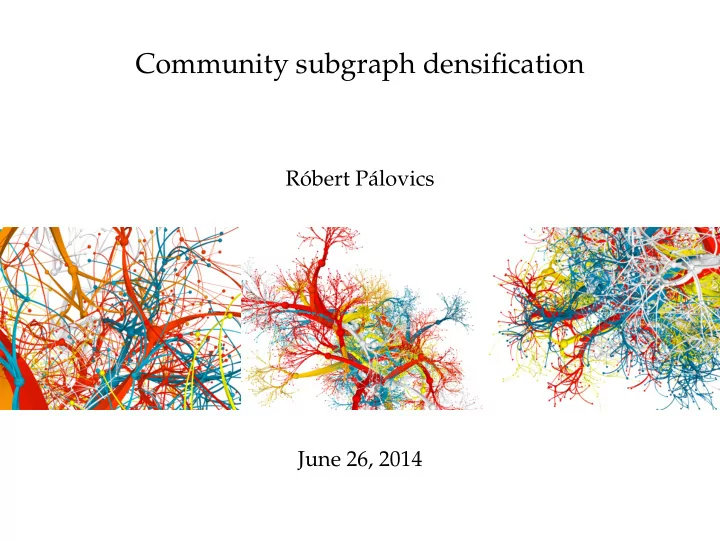

Community subgraph densification Róbert Pálovics June 26, 2014
Introduction Community densification Laws P ERSONAL ◮ Robert Palovics ◮ rpalovics@ilab.sztaki.hu ◮ Supervisor: András Benczúr ◮ BSc and MSc degree in Theoretical Physics ◮ TU Budapest ◮ Phd student in Mathematics (2nd year) ◮ TU Budapest ◮ InfoLab @ Hungarian Academy of Sciences https://dms.sztaki.hu/en/ http://www.sztaki.hu/department/INFOLAB/ ◮ computer science:)
Introduction Community densification Laws R ESEARCH INTEREST ◮ Information (epidemic) spreading in networks ◮ Cascades in online social networks ◮ Community densification laws ◮ Models of complex networks & large graphs ◮ Accelerated growth of networks ◮ Densification laws ◮ Recommender systems (RS) ◮ Online (temporal) recommendations ◮ Temporal prediction and evaluation ◮ Online collaborative filtering ◮ Context-based RS ◮ Location based RS ◮ Using social information in RS
Introduction Community densification Laws I NFORMATION SPREAD IN NETWORKS Network + Diffusion process ↔ Measurements ◮ diffusion ↔ observable time series ◮ fixed network + time series
Introduction Community densification Laws C OMMUNITY DENSIFICATION LAW ◮ Users adopt a given behavior a Datasets after each other ◮ artists in Last.fm ◮ G ( a , t ) = { subgraph of users ◮ hashtags in Twitter who adopted a before t }
Introduction Community densification Laws C OMMUNITY DENSIFICATION LAW ◮ The number of edges e ( a , t ) is power-law function of the number of nodes n ( a , t ) in the subgraph with exponent γ < 2. 100,000 10,000 number of edges e ( A , A ) 1,000 100 10 1 0.1 0.01 1 10 100 1,000 10,000 100,000 n ( A )
Introduction Community densification Laws C OMPARISON OF PROCESSES 100,000 10,000 number of edges e ( A , A ) 1,000 100 10 1 0.1 community densification 0.01 fitted curve 0.001 random picking / swapping 0.0001 epidemic simulation 1e−05 1 10 100 1,000 10,000 100,000 n ( A ) ◮ d = e 2 e e ρ = n ( n − 1 ) ∼ n n 2 ◮ Densification vs. sparsification ◮ Maximum spread
Introduction Community densification Laws A CCELERATED GROWTH OF NETWORKS 100,000 number of edges e 10,000 1,000 100 10 1 1 10 100 1,000 10,000 100,000 number of nodes n ◮ Growing network, no information diffusion ◮ L ( t ) ∝ t a + 1 e ( n ) ∝ n β
Introduction Community densification Laws N ON - ISOLATED NODES ◮ Power law fraction of nodes with at least one edge within the community, with exponent δ > 1. ◮ The edge number in a community as the function of the number nodes with at least one edge also follows power law ( β ′ ). ◮ β = β ′ (!)
Introduction Community densification Laws S UMMARY 1e+06 10,000 number of edges e 100 1 accelerated growth non-zero component densification 0.01 epidemic model community densification 0.0001 fitted curve random picking / swapping 1e−06 1 10 100 1,000 10,000 100,000 number of nodes n
Introduction Community densification Laws Network discovery process ◮ Information spreading over a network and the dynamic growth of the network are similar and closely related processes ◮ The network itself can be considered as a community in a hidden social network Work in progress ◮ Develop a network model that describes this effect ◮ Develop an information spreading model ◮ Is the degree sequence sufficient (swapping, β -model) ?
Recommend
More recommend